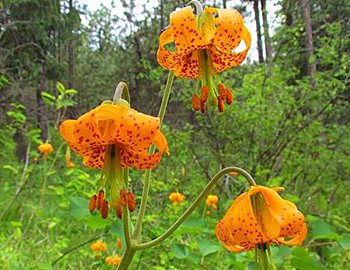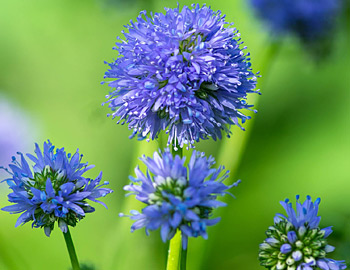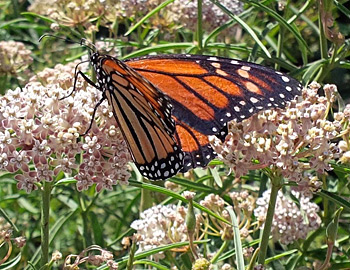PERENNIAL SEEDS
PERENNIALS
Perennial plants will live for three or more years. Many
perennials require several growing seasons to flower and produce
seed. Perennial plant seed can also be re-sewn in the landscape.
Some key things to know are: stratification and vernalization.
Stratification is the cold requirement that some seeds may require
before they will germinate, vernalization is the overwinter cold
requirement that existing plants must experience before they will
make seed heads.
Ethnobotany is the study
of a region's plants and their practical uses through the
traditional knowledge of a local culture and people. An
ethnobotanist thus strives to document the local customs involving
the practical uses of local flora for many aspects of life, such
as plants as medicines, foods, intoxicants and clothing.
Ethnobotany is investigating plants used by societies in various
parts of the world.
Perennial Info & Photos:
 Pearly Everlasting:
Anaphalis margaritacea: For dried bouquets, Pearly Everlasting is the best of our “everlasting” natives and is often used as a cut flower. It
grows in many garden settings with sunny, open sites. Flowers
begin blooming in mid-summer and extend until winter. It grows in
open meadows, roadsides, and forest openings at all elevations.
Pearly Everlasting:
Anaphalis margaritacea: For dried bouquets, Pearly Everlasting is the best of our “everlasting” natives and is often used as a cut flower. It
grows in many garden settings with sunny, open sites. Flowers
begin blooming in mid-summer and extend until winter. It grows in
open meadows, roadsides, and forest openings at all elevations.
 Yarrow: Achillea
millefolium: On dry to moist, well-drained open sites, rocky
slopes, sometimes in open forest at many elevations.
Yarrow: Achillea
millefolium: On dry to moist, well-drained open sites, rocky
slopes, sometimes in open forest at many elevations.
 Narrowleaf Milkweed:
Asclepias fascicularis: Grows in dry to moistsoil near streams in valleys, foothills. Likes direct sun.
Narrowleaf Milkweed:
Asclepias fascicularis: Grows in dry to moistsoil near streams in valleys, foothills. Likes direct sun.
 Showy Milkweed: Asclepias speciosa: Grows in fields, roadsides, near streams and
ditches.
Showy Milkweed: Asclepias speciosa: Grows in fields, roadsides, near streams and
ditches.
 Common Camas: Camas
quamash: Grows in moist meadows that dry in summer. Can be found
in oak savannahs. Lewis and Clark reported that this flowering
plant occurred in such large swaths that it resembled lakes of
clear, blue water.
Common Camas: Camas
quamash: Grows in moist meadows that dry in summer. Can be found
in oak savannahs. Lewis and Clark reported that this flowering
plant occurred in such large swaths that it resembled lakes of
clear, blue water.
 Pacific Hound's Tongue:
Cynoglossum grande: This plant likes the woods under oaks.
Pacific Hound's Tongue:
Cynoglossum grande: This plant likes the woods under oaks.
 Hooker's Fairybells::
Disporum hookeri: Grows in shaded woods with plenty of rain.
Hooker's Fairybells::
Disporum hookeri: Grows in shaded woods with plenty of rain.
 Oregon Fawn Lily:
Erythronium oregonum: Well-drained, open to dense woodlands.
Oregon Fawn Lily:
Erythronium oregonum: Well-drained, open to dense woodlands.
 Bluedicks:
Dichelostemma capitatum: Likes open woodlands, grasslands, and dry
woods.
Bluedicks:
Dichelostemma capitatum: Likes open woodlands, grasslands, and dry
woods.
 Blue Globe Gilia:
Gilia capitata: One of the easiest and most reliable showy annuals with ease
of establishment. Very attractive to honey bees, and we also see
great numbers of small ground-nesting sweat bees showing up on it,
especially on warm mornings.
Blue Globe Gilia:
Gilia capitata: One of the easiest and most reliable showy annuals with ease
of establishment. Very attractive to honey bees, and we also see
great numbers of small ground-nesting sweat bees showing up on it,
especially on warm mornings.
 Columbian Larkspur:
Delphinium trollifolium: Grows in moist, usually shady places in
oak and mixed woods where one might not expect to find colorful
blue-flowered plants. Organic matter on the forest floor is the
best soil for growth.
Columbian Larkspur:
Delphinium trollifolium: Grows in moist, usually shady places in
oak and mixed woods where one might not expect to find colorful
blue-flowered plants. Organic matter on the forest floor is the
best soil for growth.
 Oregon Iris: Iris tenax:
open areas, fields, pastures, roadsides, logged areas, and open
woodlands.
Oregon Iris: Iris tenax:
open areas, fields, pastures, roadsides, logged areas, and open
woodlands.
 Crevice Alumroot:
Heuchera micrantha: Grows on cool, rocky cliffs, established
banks, but also likes open forest glades and sunny wild gardens.
Crevice Alumroot:
Heuchera micrantha: Grows on cool, rocky cliffs, established
banks, but also likes open forest glades and sunny wild gardens.
 Tiger Lily: Lilium
columbianum: Woodlands and moist open sites, also road ditches in
the foothills.
Tiger Lily: Lilium
columbianum: Woodlands and moist open sites, also road ditches in
the foothills.
 Riverbank or
Streambank Lupine: Lupinus rivularis: Flowing water, forest,
grassland or meadows.
Riverbank or
Streambank Lupine: Lupinus rivularis: Flowing water, forest,
grassland or meadows.
 Meadow Checkermallow: Sidalcea campestris: Grassland or meadows, ecotones.
Meadow Checkermallow: Sidalcea campestris: Grassland or meadows, ecotones.
 Slender Cinquefoil: Potentilla gracilis: Likes wet spots such as marsh edges
and sufficient organic matter.
Slender Cinquefoil: Potentilla gracilis: Likes wet spots such as marsh edges
and sufficient organic matter.
 Cardwell’s Penstemon: Penstemon cardwellii: Grows on rock slopes and in forest openings.
Cardwell’s Penstemon: Penstemon cardwellii: Grows on rock slopes and in forest openings.
 Narrow Leaf Mule’s Ear:
Wyethia angustifolia: Forest, grassland, freshwater wetland, meadows.
Narrow Leaf Mule’s Ear:
Wyethia angustifolia: Forest, grassland, freshwater wetland, meadows.
 Stream Violet: Viola glabella: Moist steambanks, meadows, shady places.
Stream Violet: Viola glabella: Moist steambanks, meadows, shady places.
 Inside Out Flower: Vancouveria hexandra: Grows in deep shade in
conifer forests.
Inside Out Flower: Vancouveria hexandra: Grows in deep shade in
conifer forests.
 Western Trillium: Trillium ovatum: Likes the dim, becalmed
deciduous forest floor.
Western Trillium: Trillium ovatum: Likes the dim, becalmed
deciduous forest floor.
 Fingercups:
Tellima grandiflora: Grows in moist forests, along streams, bare
or rock-covered ground, by flowing water, and grassy meadows.
Fingercups:
Tellima grandiflora: Grows in moist forests, along streams, bare
or rock-covered ground, by flowing water, and grassy meadows.
 Canada Goldenrod:
Solidago canadensis: Prefers undisturbed sites, it would be part
of an old-fashioned flower bed. Likes wet meadows and forest
openings (ecotones).
Canada Goldenrod:
Solidago canadensis: Prefers undisturbed sites, it would be part
of an old-fashioned flower bed. Likes wet meadows and forest
openings (ecotones).
 Blue Eyed Grass:
Sisyrinchium idahoense: Dry rocky bluffs and meadows, open oak
woodlands, freshwater ponds, and scrub areas.
Blue Eyed Grass:
Sisyrinchium idahoense: Dry rocky bluffs and meadows, open oak
woodlands, freshwater ponds, and scrub areas.
 Western Red Columbine:
Aquilegia formosa: Likes open to partly shaded sites, meadows,
rocky slopes, forest glades, roadsides.
Western Red Columbine:
Aquilegia formosa: Likes open to partly shaded sites, meadows,
rocky slopes, forest glades, roadsides.
 Western Wild Ginger: Asarum caudatum: Moist and shady garden nooks, banks, edges of
Rhododendron beds, woodland glens. ( Available in 2022)
Western Wild Ginger: Asarum caudatum: Moist and shady garden nooks, banks, edges of
Rhododendron beds, woodland glens. ( Available in 2022)





